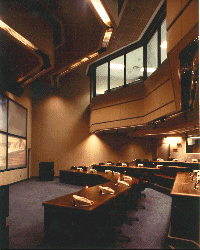

As the nerve center of the United States Strategic Command, the USSTRATCOM Command Center is prepared to transmit National Command Authority directives to strategic aircraft, submarines and missile forces.
The USSTRATCOM Command Center is located in the Underground Command Complex. Also located within this complex are the Intelligence Operations Center, Weather Support Center, Force Status Readiness Center and other support offices.
The USSTRATCOM Command Center is a specially-designed, two-level, 14,000-square-foot reinforced concrete and steel structure containing the critical information management and communication systems to provide the Commander in Chief of USSTRATCOM (CINCSTRAT) an assured capability to manage forces worldwide. In time of war, the underground would be sealed off. An underground emergency power supply, a well supplying an emergency water source, and rations would allow continuous operations without outside support for an extended period of time. Electromagnetic pulse protection is provided for critical command, control and communications equipment as well as supporting utilities. This allows CINCSTRAT to continuously exercise command over USSTRATCOM forces, even in the disturbed electromagnetic environment which would follow a high altitude nuclear burst.
When the Command Center is self-contained, CINCSTRAT and members of the senior staff would work in the lower level senior battle staff area, while support staff members would take designated positions in the support battle staff area on the second floor.
Workstation consoles provide CINCSTRAT and senior and support battle staff members state-of-the-art integrated secure/nonsecure voice communications and data management systems. Individual video monitors at each console position provide an advanced capability to display information essential to decision making and to manage the command's aircraft and missile forces. Support battle staff members have individual computer terminals which access an advanced automatic data processing system that provides word processing, spreadsheets, computational aids, graphic/tabular decision making information and automated briefing preparation and presentation.

The Command Center's group display and briefing support system provides the capability to display full motion video and still frame imagery on eight large wall screens and individual video monitors. It also allows video communications between the Command Center and weather and force status readiness centers; the capability to convert hard copy, 35 mm slides, or overhead transparencies into video; and rapid access to worldwide maps. Within seconds, vital operational data can be displayed on the large wall display screens or individual computer monitors. The primary system for storing and supplying this data is the USSTRATCOM Automated Command Control System. Information about weather, force movements, aircraft and missiles is stored in computers, ready for immediate access. Field units continually update the data.
In time of war, the computers would record strike force progress, serving as an invaluable aid to CINCSTRAT in making command and operations decisions. Because the information would be processed automatically, the battle staff would have immediate and continuous updates on its strike force.
The Primary Alerting System, using dedicated telephone circuits, enables USSTRATCOM controllers to speak directly to approximately 200 operating locations throughout the world, including missile launch control centers. Through this "Red Phone" system, each unit receives coded messages giving notice of an actual or practice alert. The Senior Controller also has a direct line to the National Military Command Center in Washington, DC, and to the other major command headquarters. This system, called the Joint Chiefs of Staff Alerting Network, allows CINCSTRAT prompt contact with the President, the Secretary of Defense, the Chairman of the Joint Chiefs of Staff, and other unified commanders.
Through satellites and radio networks (VLF, LF, UHF and HF), the Command Center can communicate with aircraft in flight over any part of the world. A principal purpose of these networks is to pass National Command Authority orders to the alert forces. Several detection systems provide the USSTRATCOM Command Center with Intercontinental Ballistic Missile (ICBM) and Sea-Launched Ballistic Missile (SLBM) attack warnings. This information is processed through high-speed computers for display on the Command Center's large screens, the CINCSTRAT's video monitors, and the Warning System Controller's video monitors.
Information shown on these screens would instantly alert the Senior Controller of an ICBM or SLBM attack against the North American continent or our allies. These systems, along with summary information and attack assessment from other military commands, permit CINCSTRAT to protect his force pending the presidential decision. Although CINCSTRAT can launch aircraft for survival, only the President can order nuclear strikes. In the event the USSTRATCOM Command Center becomes inoperable, control of strategic forces would be passed to the USSTRATCOM Airborne Command Post, which is ready to become airborne 24 hours a day.